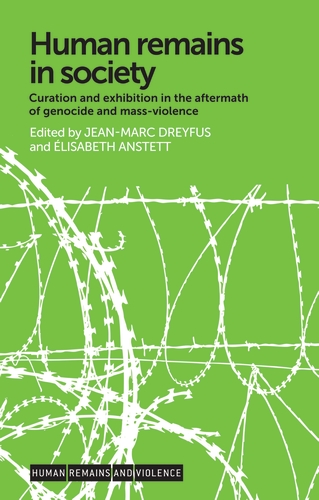Publications | Ouvrages
Human Remains in Society
Curation and exhibition in the aftermath of genocide and mass-violence
Prix : £80,00
The 5th volume from the book series with Manchester University Press: Human Remains and Violence
Human Remains in Society. Curation and exhibition in the aftermath of genocide and mass-violence
Jean-Marc Dreyfus and Élisabeth Anstett (eds)
Abstract
Whether reburied, concealed, stored, abandoned or publicly displayed, human remains raise a vast number of questions regarding social, legal and ethical uses by communities, public institutions and civil society organisations.
This book presents a ground-breaking account of the treatment and commemoration of dead bodies resulting from incidents of genocide and mass violence. Through a range of international case studies across multiple continents, it explores the effect of dead bodies or body parts on various political, cultural and religious practices.
Multidisciplinary in scope, it will appeal to readers interested in this crucial phase of post-conflict reconciliation, including students and researchers of history, anthropology, sociology, archaeology, law, politics and modern warfare.
Editor
- Jean-Marc Dreyfus is Reader in Holocaust Studies at the University of Manchester, UK and a director of the Corpses of Mass Violence and Genocide programme funded by the European Research Council
- Élisabeth Anstett is Researcher in Social Anthropology at the Centre National de la Recherche Scientifique, France and a director of the Corpses of Mass Violence and Genocide programme funded by the European Research Council
Contents
- Introduction. Corpses in society: about human remains, necro-politics, necro-economy and the legacy of mass violence - Élisabeth Anstett and Jean-Marc Dreyfus
- 1. The unburied victims of Kenya's Mau Mau Rebellion: where and when does the violence end? - David M. Anderson and Paul J. Lane
- 2. (Re)politicising the dead in post-Holocaust Poland: the afterlives of human remains at the Belzec extermination camp - Zuzanna Dziuban
- 3. Chained corpses: warfare, politics and religion after the Habsburg Empire in the Julian March, 1930s-70s - Gaetano Dato
- 4. Exhumations in post-war rabbinical responsas - David Deutsch
- 5. (Re)cognising the corpse: individuality, identification and multidirectional memorialisation in post-genocide Rwanda - Ayala Maurer-Prager
- 6. Corpses of atonement: the discovery, commemoration and reinternment of eleven Alsatian victims of Nazi Terror, 1947-52 - Devlin M. Scofield
- 7. 'Earth conceal not my blood': forensic and archaeological approaches to locating the remains of Holocaust victims - Caroline Sturdy Colls
- 8. The return of Herero and Nama bones from Germany: the victims' struggle for recognition and recurring genocide memories in Namibia - Vilho Amukwaya Shigwedha
- 9. A Beothuk skeleton (not) in a glass case: rumours of bones and the remembrance of an exterminated people in Newfoundland - the emotive immateriality of human remains - John Harries
- Index
- Manchester University Press, Series: Human Remains and Violence, November 2016, 272 pages. Hardcover ISBN: 978-1-5261-0738-1. Price: £80.00





